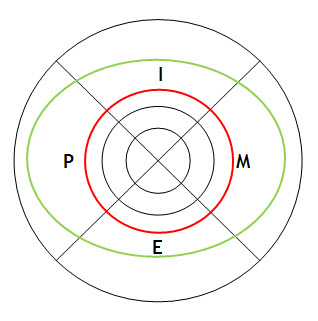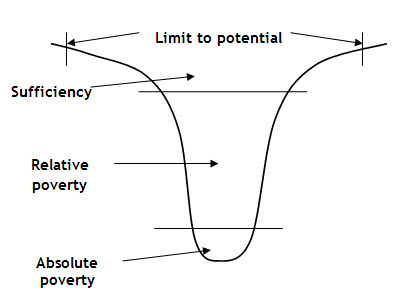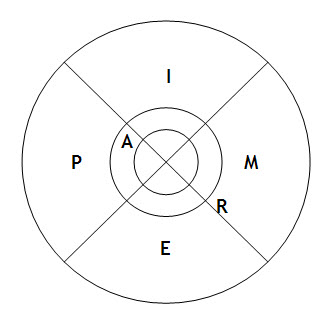It is my belief that the goal of human life is to achieve one’s potential: to seek to explore the possibilities available to you to the full within the constraints placed upon you. So, logically, you would want your area of achievement to approach the outer circle of your limit of possibility.
The clear implication of the model being proposed here is that the green area in the diagram is better for the person who enjoys it than the red area: it is not just that they appear to have more, they have come closer to fulfilling their potential for achievement, and that is their aim.

That though begs the question, is there a limit to possibility? And does that mean achievement is constrained? It is this question that fundamentally changes the approach used here from that offered by conventional economics at this time. Conventional thinking is that the individual should think their consumption unconstrained, even though the reality is otherwise. In the economics proposed here is the individual is recognised to be constrained they then recognise a different goal – which is to work to achieve within the constraint. And, of course, the answer is that the individual is constrained, and there is a limit to possibility that they must accept.
To some degree this is internally imposed by our finite nature.
It is also externally imposed. The simple reality is that we cannot consume without limit. The world is finite. Like us it has a beginning and an end. Of course, like us it also has a capacity to regenerate itself. But ultimately the laws of entropy apply: there is a limit to what is possible.
The calculation of that limit at a point of time would be complex, and has exercised me much over the years. Variables in the question would include some things unknown (which adds to the complexity) such as the relative age of the world. If it is now 99.9% through its period of human habitation we need not worry too much about human exploitation of resources: there will be enough to go round for all of us who remain. If, as most of us would I think hope, the life span for humans on earth might be somewhat longer than that then we might well take a different view. The state of biodiversity, the number of people on earth, the amount of energy we might receive from the sun and our ability to convert it, the state of our knowledge, both technical and in the form of wisdom (which I think much undervalued) have impact, and so on. I’ll not seek to develop formulas here: suffice to say that however they fall out it is clear that at a point of time we will only have claim on a limited proportion of the material resources of the world if we are to leave the world intact for those future generations we hope to follow us.
In that case it is obvious that if we define our limit to achievement as involving the best available use of the resources available to us within the external constraints that are imposed by our own finite nature and the finite nature of the world then maximising our achievement within that constraint is not something that puts us in conflict with that finite world, it does instead mean we work with that world to realise the best that is possible in life. Seeking more within the constraints of the circle drawn here is not therefore a negative exercise – it is a positive one of achieving personal potential in a way that does not cause harm.
Two further assumptions then need be made. The first is that if this is the case the available resources of the world should be allocated equally subject to the impact of geography, which is a component factor in distribution of the benefit of those resources.
The second assumption informs the first, and is that no one has an a priori claim to well-being over another person, which is a way of saying that equality of opportunity is important, even if equality of outcome cannot be achieved.
Given these two assumptions it follows that there is a fixed material amount of resource we may each enjoy at a point in time. That defines a practical limit to achievement.





